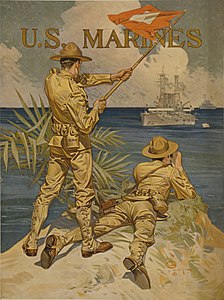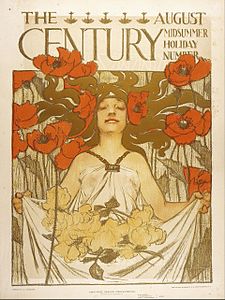art.wikisort.org - Artist
Joseph Christian Leyendecker (March 23, 1874 – July 25, 1951) was a German-American illustrator, considered one of the preeminent American illustrators of the early 20th century. He is best known for his poster, book and advertising illustrations, the trade character known as The Arrow Collar Man, and his numerous covers for The Saturday Evening Post.[1][2] Between 1896 and 1950, he painted more than 400 magazine covers. During the Golden Age of American Illustration, for The Saturday Evening Post alone, he produced 322 covers, and many advertisement illustrations for its interior pages. No other artist, until the arrival of Norman Rockwell two decades later, was so solidly identified with one publication.[3] He "virtually invented the whole idea of modern magazine design."[4]
This article uses bare URLs, which are uninformative and vulnerable to link rot. (August 2022) |
J. C. Leyendecker | |
|---|---|
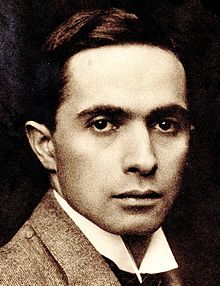 Leyendecker in 1895 | |
| Born | Joseph Christian Leyendecker March 23, 1874 Montabaur, Rhine Province, German Empire |
| Died | July 25, 1951 (aged 77) New Rochelle, New York, U.S. |
| Nationality | American |
| Education | Chicago Art Institute, Académie Julian |
| Known for | Illustration, painting |
| Partner | Charles Beach |
Early life
Leyendecker (called 'J.C.' or 'Joe') was born on March 23, 1874 in Montabaur, Germany to Peter Leyendecker (1838–1916) and Elizabeth Ortseifen Leyendecker (1845–1905). He was the first-born son; his brother Francis Xavier was born three years later. A sister, Mary Augusta, the third and last child, arrived after the family emigrated to America.[5]
In 1882, the Leyendecker family immigrated to Chicago, Illinois, where Elizabeth's brother Adam Ortseifen was vice-president of the successful McAvoy Brewing Company. After working in late adolescence for a Chicago engraving firm, J. Manz & Company, and completing his first commercial commission of 60 Bible illustrations for the Powers Brothers Company, J. C. sought formal artistic training at the school of the Chicago Art Institute.[6]
In 1895, the April–September issue of The Inland Printer had an introduction to J.C. Leyendecker. The article described his work for J. Manz & Company, and his intention to study in Paris. It featured one of his sketches, and two book covers he had illustrated, provided by E.A. Weeks, a Chicago publisher between 1893 and 1899.[7] That year, Leyendecker created his first poster, also for E.A. Weeks, for the book One Fair Daughter by Frank Frankfort Moore.[8]
After studying drawing and anatomy under John Vanderpoel at the Chicago Art Institute, J. C. and younger brother Frank enrolled in the Académie Julian[9] in Paris for a year, where they were exposed to the work of Toulouse-Lautrec, Jules Chéret, and Alphonse Mucha, a leader in the French Art Nouveau movement.[10][11]
Career

In 1899, the Leyendecker brothers returned to America and set up residence in an apartment in Hyde Park, Illinois. They had a studio in Chicago's Fine Arts Building at 410 South Michigan Ave. On May 20 of that year, Joe received his first commission for a Saturday Evening Post cover – the beginning of his forty-four-year association with the most popular magazine in the country. Ultimately he would produce 322 covers for the magazine, introducing many iconic visual images and traditions including the New Year's Baby, the pudgy red-garbed rendition of Santa Claus, flowers for Mother's Day, and firecrackers on the 4th of July.[12]

In 1900, Joe, Frank, and their sister Mary moved to New York City, then the center of the US commercial art, advertising and publishing industries. During the next decade, both brothers began lucrative long-term working relationships with apparel manufactures including Interwoven Socks, Hartmarx, B. Kuppenheimer & Co., and Cluett Peabody & Company. The latter resulted in Leyendecker's most important commission when he was hired to develop a series of images of the Arrow brand of shirt collars. Leyendecker's Arrow Collar Man, as well as the images he later created for Kuppenheimer Suits and Interwoven Socks, came to define the fashionable American male during the early decades of the twentieth century.[3] Leyendecker often used his favorite model and life partner, Charles Beach (1881–1954).[13][14][15]
Another important commission for Leyendecker was from Kellogg's, the breakfast food manufacturer. As part of a major advertising campaign, he created a series of twenty "Kellogg's Kids" to promote Kellogg's Corn Flakes.[16]
In 1914, the Leyendeckers, accompanied by Charles Beach, moved into a large home and art studio in New Rochelle, New York, where J. C. would reside for the remainder of his life.[17] During the first World War, in addition to his many commissions for magazine covers and men's fashion advertisements, J. C. also painted recruitment posters for the United States military and the war effort.
The 1920s were in many ways the apex of Leyendecker's career, with some of his most recognizable work being completed during this time. Modern advertising had come into its own, with Leyendecker widely regarded as among the preeminent American commercial artists. This popularity extended beyond the commercial, and into Leyendecker's personal life, where he and Charles Beach hosted large galas attended by people of consequence from all sectors. The parties they hosted at their New Rochelle home/studio were important social and celebrity making events.[18]
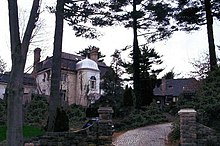
As the 1920s marked the apex of J. C. Leyendecker's career, so the 1930s marked the beginning of its decline. Around 1930–31, Cluett, Peabody, & Co. ceased using Leyendecker's illustrations in its advertisements for shirts and ties as the collar industry seriously declined after 1921. During this time, the always shy Leyendecker became more and more reclusive, rarely speaking with people outside of his sister Mary Augusta and Charles (Frank had died in 1924 as a result of an addiction-riddled lifestyle). Perhaps in reaction to his pervasive popularity in the previous decade, or as a result of the new economic reality following the Wall Street Crash of 1929, the number of commissions Leyendecker received steadily declined. In 1936, the editor at the Saturday Evening Post for all of Leyendecker's career up to that point, George Horace Lorimer, retired, and was replaced by Wesley Winans Stout (1937–1942) and then Ben Hibbs (1942–1962), both of whom rarely commissioned Leyendecker to illustrate covers.[19]
Leyendecker's last cover for the Saturday Evening Post was of a New Year Baby for January 2, 1943, thus ending the artist's most lucrative and celebrated string of commissions. New commissions continued to filter in, but slowly. Among the most prominent were posters for the United States Department of War, in which Leyendecker depicted commanding officers of the armed forces encouraging the purchases of bonds to support the nation's efforts in World War II.
Leyendecker died on July 25, 1951, at his estate in New Rochelle of an acute coronary occlusion.[19]
Personal life

Many biographers have speculated on J. C. Leyendecker's sexuality, often attributing the apparent homoerotic aesthetic of his work to a homosexual identity. Without question, Leyendecker excelled at depicting male homosocial spaces (locker rooms, clubhouses, tailoring shops) and extraordinarily handsome young men in curious poses or exchanging glances. Leyendecker never married, and he lived with another man, Charles Beach, for much of his adult life. Beach was the original model for the famous Arrow Collar Man and is assumed to have been his lover.[20]
While Beach often organized the famous gala-like social gatherings that Leyendecker was known for in the 1920s, he apparently also contributed largely to Leyendecker's social isolation in his later years. Beach reportedly forbade outside contact with the artist in the last months of his life.[21]
Due to his fame as an illustrator, Leyendecker was able to indulge in a very luxurious lifestyle which in many ways embodied the mood of the Roaring Twenties. However, when commissions began to wane in the 1930s, he was forced to curtail spending considerably. By the time of his death, Leyendecker had let all of the household staff at his New Rochelle estate go, with he and Beach attempting to maintain the extensive estate themselves. Leyendecker left a tidy estate equally split between his sister and Beach.
Leyendecker is buried alongside parents and brother Frank at Woodlawn Cemetery in The Bronx, New York City.[22] Charles Allwood Beach died of a heart attack on 21 June 1954 at New Rochelle.[23] The exact location of his burial is unknown. Although the register for St. Paul's Church, New Rochelle, indicates internment at Ferncliff Cemetery in Hartsdale, New York, the cemetery has no record of the burial.[24][25] It has since been learned that Beach was cremated at Ferncliff Cemetery. The location of his cremains there is Ferncliff Mausoleum, Unit 8, Private Storage, Niche L-001 (Not Open To The Public).</ref>[26]
Body of work
Notable clients

- Amoco
- Boy Scouts of America
- The Century Company
- Chesterfield Cigarettes
- Cluett Peabody & Company
- Collier's Weekly
- Cooper Underwear
- Cream of Wheat
- Curtis Publishing Company
- Franklin Automobile
- Hart Schaffner & Marx
- Ivory Soap
- Kellogg Company
- Kuppenheimer
- Overland Automobile
- Palmolive Soap
- Pierce Arrow Automobile
- Procter & Gamble
- The Timken Company
- U.S. Army
- U.S. Marines
- U.S. Navy
- Willys-Overland Company
Museum holdings
Examples of his work can be found in the collections of the Haggin Museum in Stockton, CA, the National Museum of American Illustration in Newport, RI, and in the Pritzker Military Museum & Library in Chicago, IL.
Legacy
As the premier cover illustrator for the enormously popular Saturday Evening Post for much of the first half of the 20th century, Leyendecker's work both reflected and helped mold many of the visual aspects of the era's culture in America. The mainstream image of Santa Claus as a jolly fat man in a red fur-trimmed coat was popularized by Leyendecker, as was the image of the New Year Baby.[27] The tradition of giving flowers as a gift on Mother's Day was started by Leyendecker's May 30, 1914 Saturday Evening Post cover[citation needed] depicting a young bellhop carrying hyacinths. It was created as a commemoration of President Woodrow Wilson's declaration of Mother's Day as an official holiday that year.
Leyendecker was a chief influence upon, and friend of, Norman Rockwell, who was a pallbearer at Leyendecker's funeral. In particular, the early work of Norman Rockwell for the Saturday Evening Post bears a strong superficial resemblance to that of Leyendecker. While today it is generally accepted that Norman Rockwell established the best-known visual images of Americana, in many cases they are derivative of Leyendecker's work, or reinterpretations of visual themes established by Rockwell's idol.
The visual style of Leyendecker's art inspired the graphics in The Dagger of Amon Ra, a video game, as well as designs in Team Fortress 2, a first-person shooter for the PC, Xbox 360, and PlayStation 3.[28]
Leyendecker's work inspired George Lucas and will be part of the collection of the anticipated Lucas Museum of Narrative Art.[29]
Leyendecker's Beat-up Boy, Football Hero, which appeared on the cover of The Saturday Evening Post on November 21, 1914, sold for $4.12 million on May 7, 2021.[30][31] The previous world record for a J. C. Leyendecker original was set in December 2020, when Sotheby's sold his 1930 work Carousel Ride for $516,100.[32]
Films and plays
In Love with the Arrow Collar Man, a play written by Lance Ringel and directed by Chuck Muckle at Theatre 80 St. Marks from November to December 2017, dramatizes the life of Leyendecker and his life partner Charles Beach.
Coded, a 2021 film documentary, tells the story of Leyendecker and premiered at the TriBeCa Film Festival in 2021.[33]
Gallery
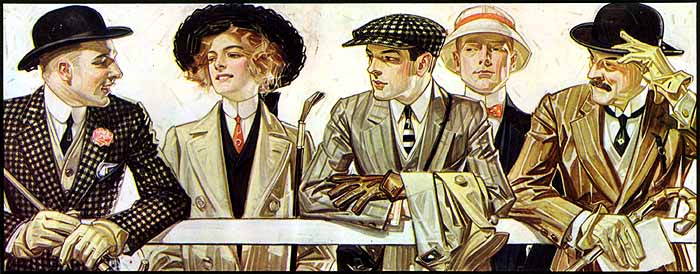 Illustration for Arrow Collar, 1907. J.C. Leyendecker
Illustration for Arrow Collar, 1907. J.C. Leyendecker- Arrow Shirt ad from the 1920s
- Leyendecker's December 28, 1907 cover of The Saturday Evening Post
- Cover of The Saturday Evening Post August 19, 1911
- Illustration for Queen Maev in Myths and Legends of the Celtic Race, 1911
- Drawing from 1913
- Study for the cover of The Saturday Evening Post
 Ad asking Americans to enlist in the Navy
Ad asking Americans to enlist in the Navy- Poster- The Pageant and Masque of St. Louis, Forest Park, May 28–31, 1914
See also
- Frank Xavier Leyendecker
References
- "The Haggin Museum Leyendecker Collection returns to public display May–December 2010". Haggin Museum. Retrieved September 9, 2010.
He is best known for his cover work for Collier's magazine and the Saturday Evening Post, for which he produced more covers for than any other artist. His creation of the "Arrow Collar Man" in 1905, as well as the images he created for Kuppenheimer Suits, Interwoven Socks and the Cooper Underwear Company ... soon came to define the fashionable American male of the early 20th century.
- "About The Saturday Evening Post". Saturday Evening Post. Archived from the original on February 22, 2009. Retrieved September 9, 2010.
Other notable cover illustrators include J.C. Leyendecker, N.C. Wyeth, Charles Livingston Bull, and John E. Sheridan.
- "Joseph Christian Leyendecker". National Museum of American Illustration. Archived from the original on February 7, 2016. Retrieved September 9, 2010.
Between 1896 and 1950, J.C. Leyendecker painted more than four hundred magazine covers. During 'The Golden Age of American Illustration', the Saturday Evening Post alone commissioned J. C. Leyendecker to produce 323 covers as well as many advertisement illustrations for its interior pages. No other artist, until the arrival of Norman Rockwell two decades later, was so solidly identified with one publication.
- Chun, Alex (September 20, 2007). "No longer is he the 'other illustrator'; J.C. Leyendecker was idolized by Norman Rockwell, not the other way around. Finally, an exhibit of more than 50 of his originals shows why". Los Angeles Times. Retrieved September 9, 2010.
[Leyendecker] virtually invented the whole idea of modern magazine design in the early part of the century," says Fullerton Museum Center curator Richard Smith. "While Leyendecker's work is not that well known, people will walk away from the experience of seeing his originals thinking they know a little more about illustration and the master of it that Leyendecker was.
- Schau, Michael (1974). J.C. Leyendecker. Watson-Guptill Publication. p. 14. ISBN 0-8230-2757-0.
- Schau, Michael (1974). J.C. Leyendecker. Watson-Guptill Publication. pp. 14–15. ISBN 0-8230-2757-0.
- The Inland Printer. Maclean-Hunter Publishing Corporation. 1895.
- Leyendecker, J. C. (Joseph Christian) (1895). "One fair daughter by Frank Frankfort Moore". www.loc.gov. Retrieved July 14, 2021.
- "glbtqarchive.com" (PDF). Glbtqarchive.com. Retrieved October 15, 2018.
- Schau, Michael (1974). J.C. Leyendecker. Watson-Guptill Publication. p. 15. ISBN 0-8230-2757-0.
- Steine, Kent; Taraba, Frederic B. (1996). J.C. Leyendecker Collection, The. Collectors Press. ISBN 0-9635202-9-6.
- Cutler, Laurence S.; Cutler, Judy Goffman. J.C. Leyendecker: American Imagist. Harry N. Abrams. ISBN 0-8109-9521-2.
- "Arrow Collar Man Model Dies at 72 - 24 Jun 1954, Thu • Page 26". The Times Record: 26. 1954. Retrieved March 18, 2018.
- Cooper, Emmanuel (1994). The Sexual Perspective: Homosexuality and Art in the Last 100 Years in the West. Routledge. p. 132. ISBN 0-415-11100-5.
- Smith, Patricia Juliana (2002). "Leyendecker, Joseph C." glbtq.com. Archived from the original on January 30, 2011. Retrieved October 11, 2010.
- "J.C. Leyendecker (1874–1951)". Haggin Museum. Retrieved September 9, 2010.
Men's fashion was probably the most significant aspect of Leyendecker's advertising opus, but his artwork was also used to promote a host of other products, including soap, automobiles, and cigarettes. And starting in 1912, he captured the hearts of American mothers through his series of cherubic infants, winsome children and wholesome adolescents enjoying bowls of Kellogg's Corn Flakes.
- Schau, Michael (1974). J.C. Leyendecker. Watson-Guptill Publication. p. 32. ISBN 0-8230-2757-0.
- Who's Who in Gay and Lesbian History from Antiquity to World War II. Routledge; London. 2002. ISBN 0-415-15983-0.
- Meyer, Susan E. "J.C. Leyendecker." In America's Great Illustrators, 136–159. New York: H. N. Abrams, 1978.
- Smith, Patricia Juliana (December 7, 2002). "Leyendecker, Joseph C." (PDF). glbtqarchive.com..
- Norman Rockwell. My Adventures as an Illustrator.
- Wilson, Scott. Resting Places: The Burial Sites of More Than 14,000 Famous Persons, 3d ed.: 2 (Kindle Location 27882). McFarland & Company, Inc., Publishers. Kindle Edition.
- The Courier-News (Bridgewater, New Jersey) 24 Jun 1954, Page 36
- Ancestry.com. New York, Episcopal Diocese of New York Church Records, 1767-1970 [database on-line]. Lehi, UT, USA: Ancestry.com Operations, Inc., 2017. Original data: The Episcopal Diocese of New York Church Records, New York, NY.
- http://crm.ferncliffcemetery.com:81/esearch/
-
- //www.findagrave.com/memorial/69967150/charles-allwood-beach
- Segal, Eric Jefferson. "Realizing Whiteness in U.S. Visual Culture: The Popular Illustration of J.C. Leyendecker, Norman Rockwell, and the Saturday Evening Post, 1917–1945." PhD Dissertation, University of California Los Angeles, 2002.
- Francke, Moby. Team Fortress 2 tc_hydro Developer Commentary, node 14.
- "Lakefront campus recommended for George Lucas interactive museum | Early & Often". Politics.suntimes.com. May 19, 2014. Archived from the original on May 20, 2014. Retrieved July 15, 2014.
- "'Football Hero' Scores New World Record". Antique Trader. May 11, 2021. Retrieved May 19, 2021.
- "World Record for Magazine Cover Art by J.C. Leyendecker". Fine Books Magazine. May 10, 2021. Retrieved May 19, 2021.
- "Carousel Ride". Sotheby's. 2020. Retrieved May 19, 2021.
- "Innovative Stories: Here's The 2021 Tribeca Festival Shorts Lineup". TriBeCa Film Festival. April 22, 2021. Retrieved May 19, 2021.
Further reading
- Carter, Alice A., Judy Francis Zankel, and Terry Brown. . Americans Abroad: J. C. Leyendecker and the European Academic Influence on American Illustration. New York: Society of Illustrators, 2008. ISBN 1-60530-843-9 OCLC 237005126
- Cutler, Judy Goffman, and Laurence S. Cutler. Norman Rockwell and His Mentor, JC Leyendecker. Newport, R.I. : National Museum of American Illustration, 2010. OCLC 769953338
- Cutler, Judy Goffman, and Laurence S. Cutler. J.C. Leyendecker: American Imagist. New York: Abrams, 2008. ISBN 0-8109-9521-2 OCLC 222664794
- Ermoyan, Arpi. Famous American Illustrators. [Crans, Switzerland]: Published for the Society of Illustrators by Rotovision, 1997. ISBN 2-88046-316-5 OCLC 38530600
- Leyendecker, J. C. An Exhibition of Original Poster Designs ... Under the Auspices of "The Indland Printer"... January 11 to 31, 1898. 1898. OCLC 62871338
- Leyendecker, J. C. and Michael Schau. J. C. Leyendecker. New York " Watson-Guptill Publications, 1974. ISBN 0-8230-2757-0 OCLC 874308
- Leyendecker, J. C., and Norman Rockwell. The J. C. Leyendecker Poster Book. New York: Watson-Guptill Publications, 1975. ISBN 0-8230-2758-9 OCLC 1583713
- Leyendecker, J. C. The Saturday Evening Post: An Illustrated Weekly Magazine ... December 29, 1906 ... New Year's. Philadelphia: s.n, 1906. OCLC 565522034
- Meyer, Susan E. America's Great Illustrators. New York : H. N. Abrams, 1978. ISBN 0-8109-0663-5 OCLC 3275418
- Moroney, Lindsay Anne. High Art Joins Popular Culture: The Life and Cover Art of J.C. Leyendecker. Thesis (Honors), College of William and Mary, 2004. OCLC 56995122
- Steine, Kent, J. C. Leyendecker, and Fred Taraba. The J. C. Leyendecker Collection: American Illustrators Poster Book. Portland, Ore. : Collectors Press, 1996. ISBN 0-9635202-8-8 OCLC 35297768
External links
- Leyendecker Collection at The National Museum of American Illustration
- Leyendecker biography, with illustrations from JVJ Publishing
- J.C. Leyendecker at Open Letters
- Leyendecker Collection at The Haggin Museum
- UNCG American Publishers' Trade Bindings: J.C. Leyendecker
- J. C. Leyendecker at Library of Congress Authorities, with 34 catalog records
На других языках
[de] Joseph Christian Leyendecker
Joseph Christian „J. C.“ Leyendecker (* 23. März 1874 in Montabaur, Deutschland; † 25. Juli 1951 in New Rochelle, New York) war ein US-amerikanischer Zeichner und Illustrator.- [en] J. C. Leyendecker
[fr] Joseph Christian Leyendecker
Joseph Christian Leyendecker (né le 23 mars 1874 à Montabaur, en province de Hesse-Nassau, et mort le 25 juillet 1951 à New Rochelle, dans l'État de New York) fut l'un des plus importants illustrateurs américains du début du XXe siècle. Il est surtout connu pour ses affiches, livres, illustrations publicitaires, ainsi que la création de la figure du « Arrow Collar Man » pour la marque Arrow, et ses couvertures pour The Saturday Evening Post[1],[2]. Entre 1896 et 1950, Leyendecker a peint plus de 400 couvertures de magazines. Pendant l'âge d'or de l'illustration américaine, pour The Saturday Evening Post seul, J. C. Leyendecker a produit 322 couvertures, ainsi que plusieurs publicités pour ses pages intérieures. Aucun autre artiste jusqu'à l'arrivée de Norman Rockwell deux décennies plus tard, ne fut plus étroitement identifié avec cette revue[3]. Leyendecker « a pratiquement inventé l'idée du concept moderne de l'illustration de magazine[4]. ».[ru] Лейендекер, Джозеф Кристиан
Джозеф Кристиан Лейендекер (англ. Joseph Christian Leyendecker; 23 марта 1874 (1874-03-23), Монтабаур, Германия — 25 июля 1951, Нью-Йорк, США) — американский иллюстратор. Известен созданием рекламных постеров для компании «Arrow Collar» и многочисленных обложек журнала «The Saturday Evening Post». Многие из его работ находятся в музее Хэггин.Другой контент может иметь иную лицензию. Перед использованием материалов сайта WikiSort.org внимательно изучите правила лицензирования конкретных элементов наполнения сайта.
WikiSort.org - проект по пересортировке и дополнению контента Википедии







